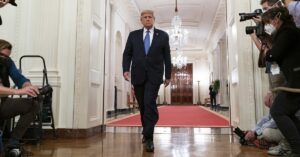Trump reshuffles National Security Council roles amid overhaul
The Trump administration continues its large-scale modification of the National Security Council (NSC), transitioning many of its responsibilities to other government branches.
This effort, led by President Donald Trump and Secretary of State Marco Rubio, aims to streamline federal operations, align with Trump's goals, and address perceived internal resistance.
The NSC has been identified by officials as a part of the federal bureaucracy populated by long-serving employees who may not support the President's objectives. As a solution, the key roles and tasks traditionally held by the NSC are being transitioned to the Department of State and the Department of Defense, under the guidance of Secretary Marco Rubio.
Recent Changes Follow Leadership Reorganization
Just before this significant restructuring effort, the organization had already seen a major staffing change under the leadership of former National Security Advisor Mike Waltz. At that time, 160 staff members were removed to better align the NSC with the President's directives. Mike Waltz's departure for the role of United Nations ambassador marked another shift, as he was previously focused on rooting out appointees from the prior administration whom he considered part of a "Deep State" within the NSC.
The responsibilities of National Security Advisor have since been assumed by Secretary of State Marco Rubio, who is juggling both roles. In addition, two new deputy national security advisors have been named: Andy Barker, who advises Vice President JD Vance, and Robert Gabriel, an assistant to President Trump for policy.
The administration believes these structured changes will enhance the effectiveness of the national security process and propel it in a direction more closely aligned with current policies.
Deeper Motivations Behind The Restructuring
A major impetus behind this overhaul is the administration's effort to target what it describes as the "Deep State," a term used by President Trump and his allies to describe the entrenched bureaucracy they believe opposes his administration. An anonymous White House official was quoted in the media, highlighting this intention by stating the effort was about "gutting the Deep State."
This perception of internal resistance has triggered a focus on reassigning critical functions to agencies more directly controlled by the Trump administration. The President and Secretary Rubio regard this as crucial to implementing their policy objectives without bureaucratic hindrances that have been described as leftover from previous administrations.
The U.S. Agency for International Development (USAID) is another focus of this realignment. Plans to dismantle USAID involve transferring its responsibilities to the State Department, aiming to enhance foreign aid efficiency and reduce staff numbers.
Public And Media Response To The Overhaul
These transitions at USAID are expected to result in significant reductions in personnel, aligning with the administration’s intent to streamline operations and cut costs. This move is one facet of the broader agenda to tighten the federal government’s operational scope, thereby eliminating perceived redundancies.
The unveiling of these changes was initially reported by the media outlet Axios, with subsequent confirmations from other sources, including Fox News Digital. These media revelations have sparked discussions in political and public domains about the depth and intentions behind such structural transitions.
While supporters argue that these changes are necessary to actualize President Trump’s strategies and optimize government performance, critics express concerns over the potential loss of institutional knowledge and the implications of further politicizing non-partisan agencies.
Long-term Implications For Federal Agencies
The evolving role of the National Security Council and related changes reflect a complex reorganization aimed at consolidating defense and foreign policy. As these agencies recalibrate their missions, the administration remains committed to achieving efficiencies and focusing resources on targeted objectives.
With the ongoing shifts in personnel and responsibilities, the ultimate effectiveness of these changes remains to be seen. Observers continue to watch closely as the Department of Defense and State Department assume their expanded duties with a focus on expediting decision-making processes.
As the Trump administration continues its tenure, the impact of these initiatives on domestic and international policy will likely be scrutinized for effectiveness and alignment with broader strategic interests.




